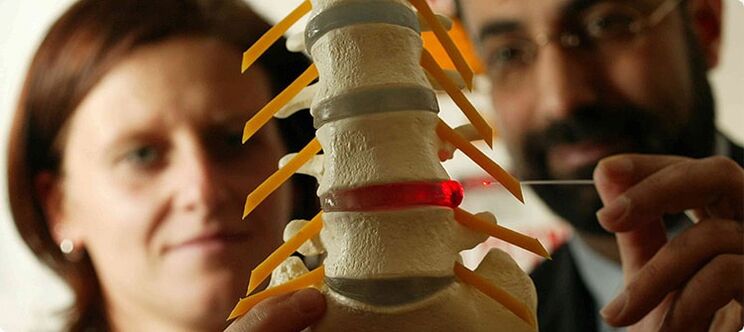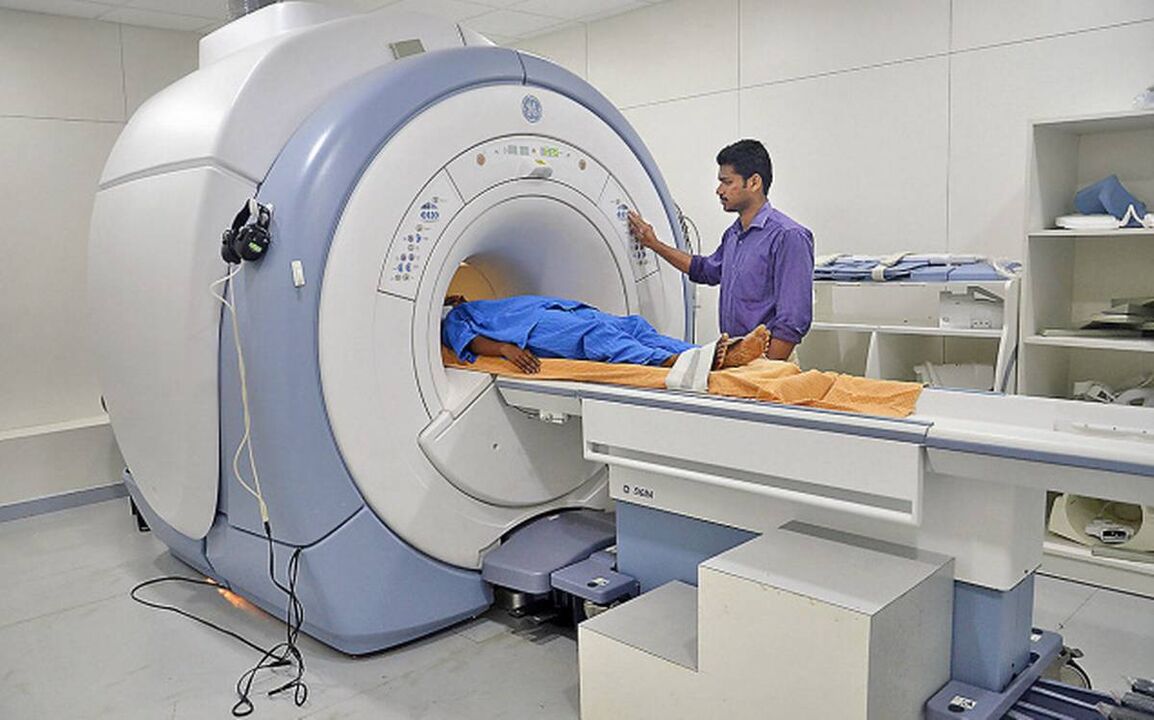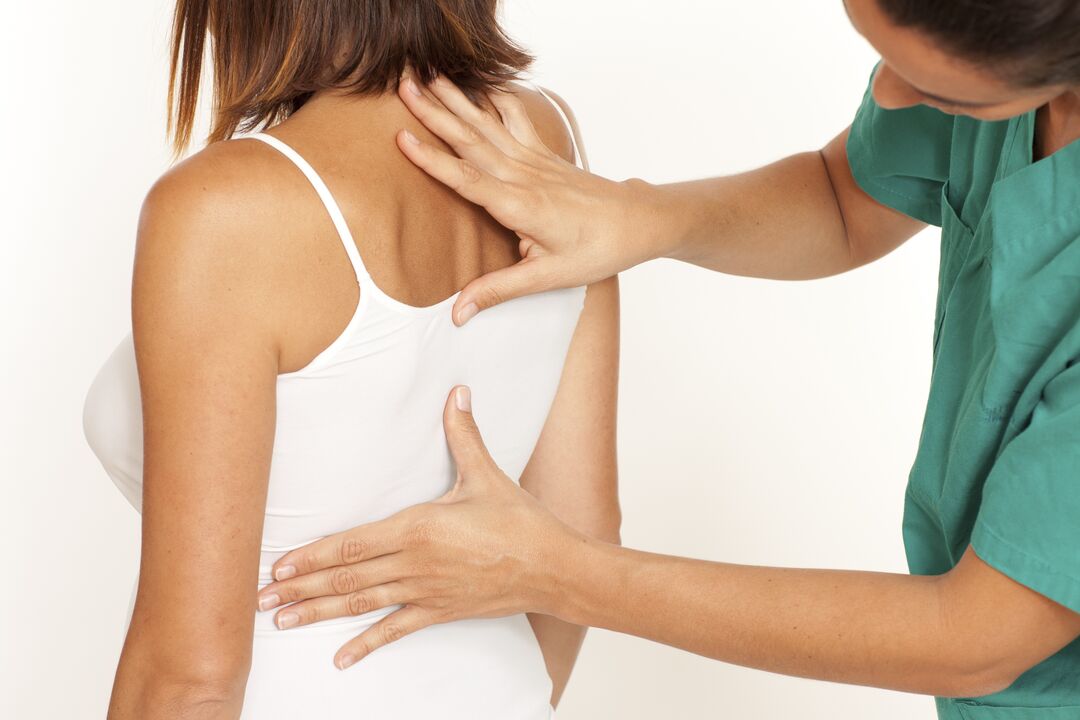Symptoms of thoracic osteochondrosis depend on which vertebra has suffered dystrophic damage, and their intensity depends on what changes have occurred in it. An experienced specialist, having listened to the patient's complaints, will be able to make the correct diagnosis and suggest which part of the spine has undergone serious changes and destruction. The sooner the doctor diagnoses thoracic osteochondrosis and prescribes medication, the sooner relief will come.
Thoracic osteochondrosis is much less common than cervical osteochondrosis, since the thoracic spine is less susceptible to stress and strain. But, nevertheless, it causes a lot of pain and discomfort and has a wide range of symptoms.

Thoracic osteochondrosis, symptoms and signs
The pain is localized mainly between the shoulder blades or in the intercostal space. Often, thoracic osteochondrosis is manifested by girdle pain in the costal part of the body. Patients describe such pains with a feeling of "pecking in the chest", their mobility is disturbed, since the pain pierces at the slightest careless movement. The pain is aggravated by coughing, sneezing, deep breathing and rotation of the torso. Shortness of breath appears, breathing becomes shallow and frequent. It is very difficult for the patient to lift or tilt his hands, as this causes sharp and intense pain. The inconvenience is also caused by body vibration, that is, riding a bicycle, a car on a rough road, as well as jumps. Cooling of the body can cause an exacerbation of pain, even with proper treatment the disease can begin with renewed vigor.
Often the pain is in the spaces between the ribs. This is due to compression of the nerve roots, which leads to intercostal neuralgia. Pain sensations become stronger at night, when turning from side to side or changing posture, the patient wakes up from sharp, piercing pain, even despite treatment with painkillers.
Sweating, fatigue and rapid fatigue join the signs of pain, sometimes there is an increase in temperature locally on the inflamed segment of the spine.

Signs of dorsago and back pain
A strong and very sharp pain is called dorsago. With thoracic osteochondrosis, symptoms of dorsago occur in people who stand still for a long time in a forward tilted position of the body. With a sharp rise or change of position, the body is pierced by sharp, sharp pain. It's so loud and unexpected that it takes your breath away and makes it hard to breathe. The muscles of the chest and back become like stone, sometimes pierced with cramps. The treatment alleviates the pain and brings relief to the patient.
Back pain, on the contrary, is a pain that is aching in nature. He is not very intense, but constantly reminds himself. With sudden and rapid movements, coughing, sneezing or deep inspiration, the body also pierces with sharp and lightning-fast pains. Bends and tilts of the body are also given with difficulty and pain. The back and chest muscles are tense and the sensation predominates, as if the upper body is being pulled by a belt.
In order to get rid of or temporarily alleviate the condition of these pains, sometimes it is enough to walk or do a light workout.
Signs of a neurological nature in osteochondrosis
Most often, osteochondrosis of the thoracic segment is given, symptoms of a neurological nature. This manifests as a "goosebumps" sensation or loss of sensation in the abdomen or upper chest. Sometimes patients note tension or stiffness in the muscles of the back, mainly the upper part, as well as the chest. In more severe and advanced cases, there is a violation of the work of the pelvic organs.
In men and women, thoracic osteochondrosis proceeds almost the same, and the symptoms are similar. The only difference is that women have a later manifestation of the disease. Women are prone to this disease during menopause. This is due to a decrease in the hormone progesterone, which protects the spine, or rather spinal discs, from wear and tear.
With osteochondrosis, a woman may experience strange symptoms, such as peeling skin and brittle nails. Women are more difficult to tolerate both thoracic and cervical osteochondrosis, this is due to the weak pain defect of the weaker sex.
Men, on the other hand, turn to specialists with osteochondrosis of the chest region much more often than women, and the average age is about 30-40 years. Men may complain of a decrease in potency. The most important thing here is to tell the doctor about the intimate problem and not treat it yourself.
Signs of osteochondrosis that can be confused with other diseases
Since there are many nerve fibers and endings in the chest area, pain behind the breastbone can therefore radiate in all directions. Symptoms of osteochondrosis are very similar to those of other diseases, which aggravates the situation with the diagnosis. Early diagnosis of osteochondrosis and initiation of treatment are very important for a more favorable course of the disease.
Many people confuse osteochondrosis with heart disease. But here it is worth remembering some differences. First, with thoracic osteochondrosis, the pain is longer in time and cannot be treated with cardiac drugs. And the second sign is that there is no increase in blood pressure, as often happens with diseases of the cardiovascular system. And most importantly, the results of the ECG do not show any abnormalities in the work of the heart.
In women, the pain can spread to the mammary glands, and this sign of thoracic osteochondrosis is very common. In this situation, it is necessary to consult a mammologist and exclude a disease of the mammary glands.
Sometimes the patient complains of pain in the epigastric region, which can be confused with gastritis or stomach ulcers. Pain can also be localized in the right hypochondrium, and unqualified medical personnel may suspect cholecystitis or pancreatitis. With pain in the lower abdomen, appendicitis can be suspected. In such cases, it is advisable to conduct an additional examination of ultrasound of the abdominal organs, X-ray and EGD of the stomach and, of course, a clinical blood test.
If the lower part of the thoracic spine is affected, the patient will show signs of intestinal diseases. But this condition does not depend on the food taken, and the pain is aggravated by physical exertion.

If osteochondrosis has affected the upper part of the spine, the pain will spread to the pharynx and esophagus. The patient will experience signs of a foreign body in the throat and may have difficulty swallowing food, especially poorly chewed food.
Only a doctor should deal with diagnosis and treatment, self-medication in this case is unacceptable.
The influence of the profession on the development of osteochondrosis
The specifics of certain professions can develop osteochondrosis. This is due to a sedentary lifestyle, especially in professions such as truck drivers, pilots, machinists. And also in the risk group are professions associated with lifting weights, for example, loaders. With prolonged lifting and carrying large loads, rubbing and flattening of part of the vertebrae occurs, which also leads to osteochondrosis and not only the thoracic, but also the cervical and lumbar segments of the spine. In more advanced cases, the arms or back begin to go numb closer to the shoulder blade area. This is a red flag to contact a specialist for examination and treatment.
Most office workers are prone to cervicothoracic osteochondrosis. That is, not only the vertebrae of the thoracic region, but also the cervical vertebrae are involved in the process of change and destruction. Due to prolonged sitting in front of computers, and even in the wrong position, it leads to weakening and flaccidity of the muscles that support the spine. The vertebrae begin to move, thereby pinching the nerves.
In addition, being immobile in one position, the blood flow of the intervertebral discs is disturbed, which leads to the starvation of the tissues of the disc and their destruction. They feel pain in the head, shoulders and chest. They have hearing loss and tinnitus. With a strong elevation or movement of the head, the employee may lose consciousness, since the work of the vestibular apparatus is disturbed. Vision is often impaired and flies appear in front of the eyes. The muscles of the shoulder girdle and chest begin to ache, as after a long exercise.
It happens that after treatment it is worth changing professions, since frequent relapses in the former place of work are possible.































